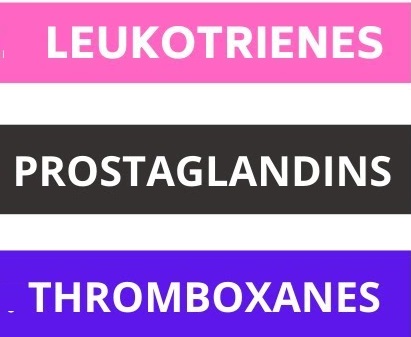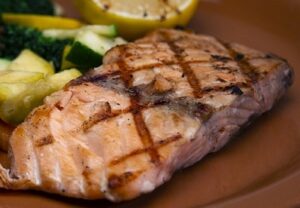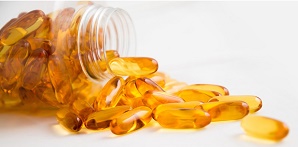
Chart of significant eicosanoids and their effects

Prostanoids: Prostaglandins & Thromboxanes(produced in most cells via enzymes COX-1 (housekeeping) and COX-2 (mostly induced under stress conditions) |
|||
PGE1 |
Directly derived from: Omega-6 DGLA in breast milk. via COX enzymes. | ||
Indirectly derived from: Omega-6 LA in nuts, seeds, vegetable oils, or legumes or GLA in borage, evening primrose or blackcurrant oil, which can all ultimately be converted to Omega-6 AA, and then to more inflammatory /active eicosanoids PG2, TX2, LT4. and EX4. However – this omega-6 AA pathway leading to more inflammatory eicosanoids competes with omega-3 presence for Δ5D, Δ6D and COX enzymes that prefer pathways to the more calming, anti-inflammatory PG1 (incl. PGE1), TX1, PG3, TX3 and LT5 series of eicosanoids.Sufficient omega-3 SDA (in blackcurrant / wild seed oil or derived from omega-3 ALA foods) must be present to ensure COX enzyme conversion of Omega-6 DGLA to anti-inflammatory PG1 series (incl. PGE1) by competing for Δ5D enzymes, instead of COX conversion to Omega-6 AA and then the more active eicosanoids. “EFA Conversion Chart” provides a visual aid to understanding these complicated, interacting conversion pathways. |
|||
| P G E 1 | ALL CELLS |
Anti-inflammatory |
Reduce Pain |
| Sesame lignans promote conversion of omega-6 DGLA to anti-inflammatory PGE1 in favor of pro-inflammatory omega-6 AA | |||
|
Inhibit cell proliferation |
|||
| P G E 1 | BLOOD / LYMPH VESSELS |
Vasodilator |
|
| P G E 1 | PLATELETS | Inhibits platelet aggregation (clotting) | |
| P G E 1 | IMMUNE SYSTEM CELLS |
I.S.Booster |
|
| P G E 1 | BRONCHIAL AIRWAYS |
Dilator |
|
PGD2 |
Directly derived from: Omega-6 AA in meat and eggs. If present, Omega-3 EPA competes for COX-1 or COX-2 enzymes reducing their conversion of Omega-6 AA to PGD2 and other inflammatory /active eicosanoids: PG2, TX2, LT4. and EX4. | ||
| Indirectly derived from: Omega-6 LA in nuts, seeds, vegetable oils, or legumes, or Omega-6 DGLA in breast milk, or GLA in borage, evening primrose or blackcurrant oil, which can all ultimately be converted to Omega-6 AA, and then to inflammatory /active eicosanoids: PG2 (incl. PGD2), TX2, LT4. and EX4 via COX enzymes.. However – this omega-6 AA pathway leading to more inflammatory eicosanoids competes with omega-3 presence for Δ5D, Δ6D and COX enzymes that prefer pathways to the more calming, anti-inflammatory PG1 (incl. PGE1), TX1, PG3, TX3 and LT5 series of eicosanoids. “EFA Conversion Chart” provides a visual aid to understanding these complicated, interacting conversion pathways. | |||
| P G D 2 | AIRWAYS; |
Potent bronchial contractor |
|
| Released by I.S. Mast cells – Involved in allergic rhinitis and allergic bronchial asthma. Attracts neutrophils (WBCs that fight infection and heal injuries). Involved in late phase reactions to allergens (6 hrs after exposure). PGD2 has 10 times higher concentration in asthma patients compared to control patients. | |||
| P G D 2 | PULMONARY PLACENTAL VESSELS |
Potent vasoconstrictor |
|
| Released by I.S. Mast cells – PGD2 is a potent vasoconstrictor via thromboxane/endoperoxide (TX/E) receptor activation in pulmonary vessels, but this mechanism is not responsible for vasoconstriction in systemic vessels or in airway. King, 1991 | |||
| P G D 2 | BLOOD / LYMPH VESSELS |
Potent vasoconstrictor |
Raise BP |
| PubMed | |||
| P G D 2 | UTERINE blood vessels |
MILD Vasodilator |
|
| Released by Mast Cells – PGD2 can promote mild vasodilation if TX/E is blocked. King, 1991 PGD2 dilates uterine blood vessels. Together with its ability to constrict placental blood vessels, it may control utero-placental blood flow. | |||
| P G D 2 | Mast cells in BRAIN | ||
Most abundant prostanoid in mammalian brain; PGD2 promotes sleep [Encyclopedia of Sleep, 2013] |
|||
| P G D 2 | Mast cells in SKIN |
Vasodilator |
|
| PGD2 is the primary mediator of vasodilation after taking niacin (vitamin B3) – the so-called “niacin flush”. Involved in urticuria (hives), and balding- a causal link was found between elevated levels of localized PGD2 and hair growth inhibition (byincreasing Prostaglandin D2 synthase). Garza et al, 2012. | |||
PGE2 |
Directly derived from: Omega-6 AA in meat and eggs. If present, Omega-3 EPA competes for COX-1 or COX-2 enzymes reducing their conversion of Omega-6 AA to PGD2 and other inflammatory /active eicosanoids: PG2, TX2,, LT4. and EX4. | ||
| Indirectly derived from: Omega-6 LA in nuts, seeds, vegetable oils, or legumes, or Omega-6 DGLA in breast milk, or GLA in borage, evening primrose or blackcurrant oil, which can all ultimately be converted to Omega-6 AA, and then to inflammatory /active eicosanoids: PG2 (incl. PGE2), TX2, LT4. and EX4 via COX enzymes.. However – this Omega-6 AA pathway leading to more inflammatory eicosanoids competes with omega-3 presence for Δ5D, Δ6D and COX enzymes that prefer pathways to the more calming, anti-inflammatory PG1 (incl. PGE1), TX1, PG3, TX3 and LT5 series of eicosanoids. “EFA Conversion Chart” provides a visual aid to understanding these complicated, interacting conversion pathways. | |||
| P G E 2 | BRAIN; JOINTS |
Inflammatory /Increase Pain Via Cox-2 – Promotes all signs of classic inflammation: i.e. redness, swelling and pain. Redness and edema result from increased blood flow into the inflamed tissue through PGE2-mediated increase in arterial dilation and microvascular permeability. Pain results from the action of PGE2 on peripheral sensory neurons and on central sites within the spinal cord and the brain Quercetin reduces PGE2 in RA joints Link |
|
| P G E 2 | AIRWAYS |
Dilator |
|
| P G E 2 | Walls of: BLOOD / LYMPH VESSELS. STOMACH, INTESTINE, BLADDER, UTERUS |
Vasodilator
Normalize BP |
Smooth muscle relaxer |
| Dilates blood vessels in kidneys PubMed Relaxes Vascular SMCs which form the supporting tissue of arteries, veins, capillaries & lymphatic vessels) and SMCs in walls of other hollow organs: stomach, intestine, bladder, uterus, others | |||
| P G E 2 | PLATELETS | ||
| STOMACH /INTESTINAL MUCOSA | Image gastric mucosa | ||
| P G E 2 | Via Cox1 – Protects stomach and intestinal lining; Gastric mucosa: ↑ mucous /bicarbonate secretion; ↑ mucosa blood flow; ↓ gastric acid /PEPSIN secretion; Intestinal mucosa: ↑ duodenal mucus secretion Provides gastrointestinal integrity (via Cox-2?) | ||
| TUMORS Cell proliferation | Image cell proliferation | ||
| P G E 2 | Promotes tumor growth: PGE2 is the most abundant prostaglandin found in various human malignancies, including colon, lung, breast, and head and neck cancer, also often associated with a poor prognosis. In contrast, the enzyme that catalyzes the degradation of PGE2 (15-PGDH, an antagonist /suppressor of Cox-2) is highly expressed in normal tissues but is ubiquitously lacking in human colon, gastric, lung and breast cancer resulting in increased endogenous PGE2 levels in these tumors. Furthermore, there may be a negative feedback loop, since a product of the Cox-2 enzymatic pathway, upregulates the expression of 15-PGDH in breast cancer MDA-MD-231 cells. 15-PGDH is being investigated as a potential avenue for tissue regeneration. PubMed. Prostaglandin E Synthase (PGES) converts PGH to PGE | ||
| FERTILITY | |||
| Regulates immune responses; Involved in fertility | |||
| UTERUS | |||
| Dinoprostone (PGE2) is an FDA approved drug for evacuating the uterus (i.e. promoting abortion or inducing labor; helps dilate cervix) | |||
PGF2α |
Directly derived from: Omega-6 AA in meat and eggs. If present, Omega-3 EPA competes for COX-1 or COX-2 enzymes reducing their conversion of Omega-6 AA to PGF2α and other inflammatory /active eicosanoids: PG2, TX2,, LT4. and EX4. | ||
| Indirectly derived from: Omega-6 LA in nuts, seeds, vegetable oils, or legumes, or Omega-6 DGLA in breast milk, or GLA in borage, evening primrose or blackcurrant oil, which can all ultimately be converted to Omega-6 AA, and then to inflammatory /active eicosanoids: PG2 (incl. PGF2α), TX2, LT4. and EX4 via COX enzymes.. However – this omega-6 AA pathway leading to more inflammatory eicosanoids competes with omega-3 presence for Δ5D, Δ6D and COX enzymes that prefer pathways to the more calming, anti-inflammatory PG1 (incl. PGE1), TX1, PG3, TX3 and LT5 series of eicosanoids. “EFA Conversion Chart” provides a visual aid to understanding these complicated, interacting conversion pathways. | |||
P G F 2 α |
AIRWAYS |
 |
|
| Constricting; Anomaly: Promoted by Cox1 inhibitors (aspirin, traditional NSAIDs) Harrington, 2008 | |||
| P G F 2 α | Walls of: BLOOD / LYMPH VESSELS. STOMACH, INTESTINE, BLADDER, UTERUS |
Vaso-Constricting
|
Image contracting SMC |
| Via Cox-2 – CONSTRICTS Vascular SMCs which form the supporting tissue of blood vessels in arteries, veins, lymphatic vessels; uterus CONTRACTS SMCs in other hollow organs: stomach walls, intestine, bladder, uterus | |||
| P G F 2 α | EYES | ||
| P G F 2 α | STOMACH Gastric mucosa | ||
PGI2Prostacyclin |
Directly derived from: Omega-6 AA in meat and eggs. If present, Omega-3 EPA competes for COX-1 or COX-2 enzymes reducing their conversion of Omega-6 AA to PGI2 (Prostacyclin) and ALSO reducing conversion to inflammatory /active eicosanoids: PG2, TX2,, LT4. and EX4. | ||
| Indirectly derived from: Omega-6 LA in nuts, seeds, vegetable oils, or legumes, or Omega-6 DGLA in breast milk, or GLA in borage, evening primrose or blackcurrant oil, which can all ultimately be converted to Omega-6 AA, and then to mostly inflammatory /active eicosanoids: PG2 (includes calming PGI2), TX2, LT4. and EX4 series via COX enzymes.. However – this omega-6 AA pathway leading to more inflammatory eicosanoids competes with omega-3 presence for Δ5D, Δ6D and COX enzymes that prefer pathways to the more calming, anti-inflammatory PG1 (incl. PGE1), TX1, PG3, TX3 and LT5 series of eicosanoids. “EFA Conversion Chart” provides a visual aid to understanding these complicated, interacting conversion pathways. | |||
| P G I 2 |
BLOOD / LYMPH VESSELS: |
Vasodilator |
Potent inhibitor of platelet aggregation 3 |
| PGI2 released by endothelial cells(ECs) lining blood and lymphatic vessels; (Via Cox-1 and Cox-2). Potent inhibitor of platelet aggregation (clot formation), also inhibits fibroblast proliferation, and leukocyte adhesion. | |||
P G I 2 |
SMOOTH MUSCLE CELLS (SMCs) |
SMC Relaxer |
|
| PGI2 regulates smooth muscle cells; counteracts Thromboxane A2 (TXA2) | |||
P G I 2 |
BRONCHIAL AIRWAYS |

Bronchial dilator |
|
| Released by epithelial cells (EPCs) lining airways, Prostacyclin (PGI2) has a beneficial effect on allergic airway responses and pulmonary hypertension. e.g. in asthma. Zhou, 2016 | |||
P G I 2 |
PLATELETS | image for deaggregation Potent Inhibitor | |
| Via Cox2 – P G I 2 is a potent inhibitor of clot formation | |||
| P G I 2 |
KIDNEY, LIVER, LUNG, HEART |
Anti-inflammatory |
|
P G I 2 |
STOMACH Gastric mucosa |
Vasodilator Via Cox1. Protects stomach (gastrointestinal) lining / epithelial cells |
|
TXA2Thromboxane(TXA2 ==>TXB2) |
Directly derived from: Omega-6 AA in meat and eggs. If present, Omega-3 EPA competes for COX-1 or COX-2 enzymes reducing their conversion of Omega-6 AA to PGF2α and other inflammatory /active eicosanoids: PG2, TX2,, LT4. and EX4. | ||
| Indirectly derived from: Omega-6 LA in nuts, seeds, vegetable oils, or legumes, or Omega-6 DGLA in breast milk, or GLA in borage, evening primrose or blackcurrant oil, which can all ultimately be converted to Omega-6 AA, and then to inflammatory /active eicosanoids: PG2, TX2 (incl. TXA2),, LT4. and EX4 via COX enzymes. However – this omega-6 AA pathway leading to more inflammatory eicosanoids competes with omega-3 presence for Δ5D, Δ6D and COX enzymes that prefer pathways to the more calming, anti-inflammatory PG1 (incl. PGE1), TX1, PG3, TX3 and LT5 series of eicosanoids. “EFA Conversion Chart” provides a visual aid to understanding these complicated, interacting conversion pathways. | |||
| T X A 2 | BLOOD / LYMPH VESSELS |
Vaso-constricting
|
|
| T X A 2 | PLATELETS | Blood clotting¹ Via Cox-1 Involved in thrombosis | |
| T X A 2 | VASCULAR SMOOTH MUSCLE
|
Cell proliferation aids damage repair. Involved in development of atherosclerosis; | |
|
VSMC proliferation |
|||
| T X A 2 | AIRWAYS |  |
|
| An anomaly is that bronchoconstriction is promoted by Cox-1 inhibitors (aspirin, traditional NSAIDs), but not selective Cox-2 inhibitors. Harrington, 2008 | |||
| T X A 2 | PLACENTA | ||
| T X A 2 | KIDNEY | ||
| T X A 2 | Macrophages | ||
Series 3PGs |
Derived from: Omega-3 EPA e.g. in salmon, fish or krill oil, Brown / red algae. Grass-fed animals and poultry, land animals’ brains testes, adrenals, eyeballs. Mm Mmm Mmmmm! Compete for COX enzymes in prostanoid (prostaglandin and thromboxane) PG1, TX1, PG2 / PG2, TX2 pathways to eicosanoids, | ||
Fish oil capsules4 |
|||
| MOST CELLS |  Anti-inflammatory via Cox1 and Cox 2 COUNTER PG-2s / LT-4s. Compete for COX and 5-LO enzymes Anti-inflammatory via Cox1 and Cox 2 COUNTER PG-2s / LT-4s. Compete for COX and 5-LO enzymes |
||
Leukotrienes |
|||
Series 4LTs |
Directly derived from: Omega-6 AA in meat and eggs. If present, Omega-3 EPA competes for 5-LO enzymes reducing their conversion of Omega-6 AA to inflammatory /active LT4 and also EX4 series eicosanoids. | ||
| Indirectly derived from: Omega-6 LA in nuts, seeds, vegetable oils, or legumes, or Omega-6 DGLA in breast milk, or GLA in borage, evening primrose or blackcurrant oil, which can all ultimately be converted to Omega-6 AA, and then to inflammatory /active eicosanoids: series PG2 and TX2, via COX enzymes, or LT4 and EX4 via 5-LO enzymes. However – this omega-6 AA pathway leading to more inflammatory eicosanoids competes with omega-3 presence for Δ5D, Δ6D and COX and 5-LO enzymes that prefer pathways to the more calming, anti-inflammatory PG1 (incl. PGE1), TX1, PG3, TX3 and LT5 series of eicosanoids. “EFA Conversion Chart” provides a visual aid to understanding these complicated, interacting conversion pathways. | |||
| AIRWAYS |

|
||
| Mast cells via 5-LO (concurrent release with histamine). Part of the inflammation response, especially in asthma and allergic rhinitis. Attract white blood cells to sites of tissue damage and cause smooth muscles to contract. LTC4 and LTD4 increase respiratory mucous secretion. PubMed | |||
Series 5LTs |
Directly derived from: Omega-3 EPA e.g. in salmon, fish or krill oil, Brown / red algae. Grass-fed animals and poultry, land animals’ brains testes, adrenals, eyeballs. Mm Mmm Mmmmm! Compete for 5-LO enzymes in LT4, EX4 pathways to eicosanoids, | ||
Mast cells via 5-LO Counters inflammation |
|||
Specialized Pro-resolving Mediators (SPMs)
|
|||
Lipoxins |
Derived from: Omega-6 AA in meat and eggs | ||
| With sufficient presence of omega-3 EPA : Indirectly derived from: Omega-6 LA in nuts, seeds, vegetable oils, or legumes or Omega-6 DGLA in breast milk or GLA in borage /evening primrose oil. Low dose aspirin can also trigger LIPOXIN synthesis | |||
| Neutrophils | Via 15-LO From AA | ||
| Erythrocytes, Reticulocytes | Via 12-LO From AA | ||
| Platelets | Via 12-LO From LTA5 | ||
Resolvins(RVs) |
Derived from: Omega-3 EPA or DHA e.g. in salmon, fish or krill oil | ||
| Newly discovered. Resolve inflammation, Clear away inflammation debris. Modulates immune system (IS). Serhan et al, 2000 Block prostanoid effects | |||
Protectins(PDs) |
Derived from:< Omega-3 EPA or DHA e.g. in salmon, fish or krill oil | ||
| Tissue protective | Protectin D1 (derived from DHA) protects tissue including neuronal tissue from excessive damage Serhan et al. 2002 | ||
Eoxins(EXs) |
Derived from: Omega-6 AA in meat and eggs (competing for | ||
| With sufficient presence of omega-3 EPA: Indirectly derived from: Omega-6 LA in nuts, seeds, vegetable oils, or legumes or Omega-6 DGLA in breast milk or GLA in borage /evening primrose oil. | |||
| Eosinophils (WBCs), Mast cells | Via 15-LO-1 Involved in asthma, lymphoma of Hodgkins disease, prostate cancer, colon cancer, and other cancers | ||
References
Garza, Luis A.; et al. (2012, Mar 12). “Prostaglandin D Inhibits Hair Growth and Is Elevated in Bald Scalp of Men with Androgenetic Alopecia”. Science Translational Medicine. 4 (126): 126ra34.PubMed
Green, P., Gispan-Herman, I., & Yadid, G. (2005). Increased arachidonic acid concentration in the brain of Flinders Sensitive Line rats, an animal model of depression. Journal of lipid research, 46(6), 1093-1096. PubMed
Multiple functions of endothelial cells
¹Medical gallery of Blausen Medical 2014 CC BY 3.0
²Version 8.25 from the Textbook OpenStax Anatomy and Physiology (Altered) CC BY 4.0
³Guy Waterval, Apache License 2.0
4Fish oil capsules by SemtrioLicensed CC BY 2.0































